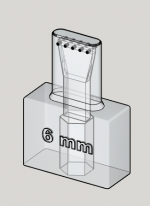Rockymount
Member
- Joined
- Jun 27, 2022
- Messages
- 4
Hi Everyone, Brand new to the forum, so apologies if someone has already posted about this. I did do a search but couldn't find the following specific content.
I've just watched a video by ExtremeWoodworker where he spent several months perfecting 3D Festool Domino Glue Nozzle prints for 5, 6, 8 and 10mm that fits the 16oz Titebond Glue Bottles and you can download FREE 3D STL Print Design (includes flushing adapter and storage tray). Unfortunately I don't have a 3D Printer, as if I did, I'd be printing the Nozzles off right now. Here's the link to the video with a link to STL files down in the pinned comments
Happy printing [smile]
I've just watched a video by ExtremeWoodworker where he spent several months perfecting 3D Festool Domino Glue Nozzle prints for 5, 6, 8 and 10mm that fits the 16oz Titebond Glue Bottles and you can download FREE 3D STL Print Design (includes flushing adapter and storage tray). Unfortunately I don't have a 3D Printer, as if I did, I'd be printing the Nozzles off right now. Here's the link to the video with a link to STL files down in the pinned comments
Happy printing [smile]

